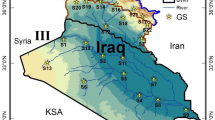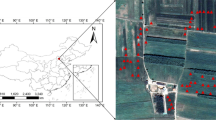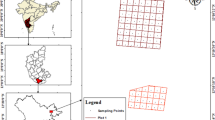Abstract
The study was focused on assessing the condition of pearl millet crop in critical growth stages using both polarimetric Radarsat-2 and dual-polarized Sentinel-1 datasets. The results revealed that bajra having a close structured phenology like maize and Jowar, exhibited significant changes in RVI due to differences in the crop calendar dates. For bajra, polarimetric RVI generated from information rich Radarsat-2 was observed to have a higher level of saturation till 6 kgm−2 biomass with a R2 of 0.7. In all instances, RVI exhibited a significant relationship with VWC and plant volume with a R2 above 0.7 due to its higher sensitivity towards crop dielectric constant. Unlike NDVI, RVI increased with an increase in Leaf Area Index till 5.8 even during panicle initiation stage. Backscatter and truncated RVI almost follow a similar trend of RVI response for various crop growth parameters. Hence, in case of regional analysis and high cost of Radarsat-2 dataset, one can use freely available sentinel data for RVI analysis due to its wider swath coverage. The observed high correlation of crop age with RVI (R2 = 0.6) proved to be the best tool for predicting sowing dates in staggered sowing zones.











Similar content being viewed by others
References
Shanmugapriya, S., Haldar, D., & Danodia, A. (2019). Optimal Datasets Suitability for Pearl Millet (Bajra) Discrimination using Multiparametric SAR Data. Geocarto International, 6049, 1–14. https://doi.org/10.1080/10106049.2019.1585485.
Bouvet, A., Le Toan, T., & Lam-Dao, N. (2009). Monitoring of the Rice Cropping System in the Mekong Delta Using ENVISAT/ASAR Dual Polarization Data. IEEE Transactions on Geoscience and Remote Sensing, 47(2), 517–526. https://doi.org/10.1109/TGRS.2008.2007963.
Dave, V. A., Haldar, D., Dave, R., Misra, A., & Pandey, V. (2017). Cotton crop biophysical parameter study using hybrid/compact polarimetric RISAT-1 SAR data. Progress in Electromagnetics Research, 57, 185–196. https://doi.org/10.2528/PIERM16121903.
McNairn, H., Shang, J., Jiao, X., & Champagne, C. (2009). The Contribution of ALOS PALSAR Multipolarization and Polarimetric Data to Crop Classification. IEEE Transactions on Geoscience and Remote Sensing, 47(12), 3981–3992. https://doi.org/10.1109/TGRS.2009.2026052.
Shanmugapriya, S., Haldar, D., & Danodia, A. (2019). Time series Sentinel-1A profile analysis for heterogeneous Kharif crops discrimination in North India. URSI AP-RASC 2019, New Delhi, India, 09–15 March 2019.
Jin, Y.-Q., & Liu, C. (1997). Biomass retrieval from high-dimensional active/passive remote sensing data by using artificial neural networks. International Journal of Remote Sensing, 18(4), 971–979. https://doi.org/10.1080/014311697218863.
Kim, Y., Jackson, T., Bindlish, R., Lee, H., & Hong, S. (2013). Monitoring soybean growth using L-, C-, and X-band scatterometer data. International Journal of Remote Sensing, 34(11), 4069–4082. https://doi.org/10.1080/01431161.2013.772309.
Tucker, C. J. (1979). Red and photographic infrared linear combinations for monitoring vegetation. Remote Sensing of Environment, 8(2), 127–150. https://doi.org/10.1016/0034-4257(79)90013-0.
Jackson, T. J., & Schmugge, T. J. (1991). Vegetation effects on the microwave emission of soils. Remote Sensing of Environment, 36(3), 203–212. https://doi.org/10.1016/0034-4257(91)90057-D.
Gao, B.-C., & Goetzt, A. F. H. (1995). Retrieval of equivalent water thickness and information related to biochemical components of vegetation canopies from AVIRIS data. Remote Sensing of Environment, 52(3), 155–162. https://doi.org/10.1016/0034-4257(95)00039-4.
Kim, Y., & van Zyl, J. (2001). Comparison of forest parameter estimation techniques using SAR data. IEEE 2001 International Geoscience and Remote Sensing Symposium, 3, 1395–1397. https://doi.org/10.1109/IGARSS.2001.976856.
Kim, Y., Jackson, T., Bindlish, R., Lee, H., & Hong, S. (2012). Radar vegetation indices for estimating the vegetation water content of rice and soybean. IEEE Geoscience and Remote Sensing Letters, 9(4), 564–568. https://doi.org/10.1109/LGRS.2011.2174772.
Tugrul Yilmaz, M., Hunt, E. R., Goins, L. D., Ustin, S. L., Vanderbilt, V. C., & Jackson, T. J. (2008). Vegetation water content during SMEX04 from ground data and landsat 5 Thematic mapper imagery. Remote Sensing of Environment, 112(2), 350–362.
Kim, Y., Jackson, T., Bindlish, R., Hong, S., Jung, G., & Lee, K. (2014). Retrieval of wheat growth parameters with radar vegetation indices. IEEE Geoscience and Remote Sensing Letters, 11(4), 808–812. https://doi.org/10.1109/LGRS.2013.2279255.
S. Mohan, A. Das, D. Haldar, and S. Maity (2014) Monitoring and Retrieval of Vegetation Parameter using Multi-frequency Polarimetric SAR Data. Asia-Pecific Conf. Synth. Aperture Radar 330–333
Haldar, D., Dave, V., Misra, A., & Bhattacharya, B. (2018). Radar vegetation index for assessing cotton crop condition using RISAT-1 data radar vegetation Index for assessing cotton crop. Geocarto International. https://doi.org/10.1080/10106049.2018.1516249.
Ferrazzoli, P., Paloscia, S., Pampaloni, P., Schiavon, G., Solimini, D., & Coppo, P. (1992). Sensitivity of microwave measurements to vegetation biomass and soil moisture content: a case study. IEEE Transactions on Geoscience and Remote Sensing, 30(4), 750–756. https://doi.org/10.1109/36.158869.
Brisco, B., Brown, R. J., Gairns, J. G., & Snider, B. (1992). Temporal ground-based scatterometer observations of crops in western canada. Canadian Journal of Remote Sensing, 18(1), 14–21. https://doi.org/10.1080/07038992.1992.10855138.
Chauhan, S., Srivastava, H. S., & Patel, P. (2018). Wheat crop biophysical parameters retrieval using hybrid-polarized RISAT-1 SAR data. Remote Sensing of Environment, 216, 28–43. https://doi.org/10.1016/J.RSE.2018.06.014.
Saxena, N., & Rathore, N. (2013). A review on speckle noise filtering techniques for SAR images. International Journal of Advanced Research in Computer Science and Electronics Engineering , 2(2), 2277–9043.
Srivastava P. K., O’Neill P., Cosh M., Lang R., Joseph A. (2015) Evaluation of Radar Vegetation Indices for Vegetation Water Content Estimation Using Data from a Ground-Based SMAP Simulator. In 2015 IEEE International Geoscience and Remote Sensing Symposium (IGARSS) 1296–1299. IEEE.
Haldar, D., Chakraborty, M., Manjunath, K. R., & Parihar, J. S. (2014). Role of polarimetric SAR data for discrimination/biophysical parameters of crops based on canopy architecture. International Archives of the Photogrammetry, Remote Sensing and Spatial Information Sciences. https://doi.org/10.5194/isprsarchives-XL-8-737-2014.
Acknowledgements
We would like to thank European Space Agency (ESA) for providing Sentinel-1 datasets and SNAP software for RVI analysis. The research was done under SUFALAM project and we are also thankful to Indian Institute of Remote Sensing (IIRS) for providing necessary resources for carrying out this research.
Author information
Authors and Affiliations
Corresponding author
Additional information
Publisher's Note
Springer Nature remains neutral with regard to jurisdictional claims in published maps and institutional affiliations.
Rights and permissions
About this article
Cite this article
Selvaraj, S., Haldar, D. & Srivastava, H.S. Condition assessment of pearl millet/ bajra crop in different vigour zones using Radar Vegetation Index. Spat. Inf. Res. 29, 631–643 (2021). https://doi.org/10.1007/s41324-021-00380-y
Received:
Revised:
Accepted:
Published:
Issue Date:
DOI: https://doi.org/10.1007/s41324-021-00380-y




